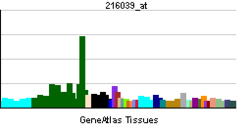GABRA2
| View/Edit Human | View/Edit Mouse |
Gamma-aminobutyric acid receptor subunit alpha-2 is a protein that in humans is encoded by the GABRA2 gene.[4]
GABA is the major inhibitory neurotransmitter in the mammalian brain where it acts at GABA-A receptors, which are ligand-gated chloride channels. Chloride conductance of these channels can be modulated by agents such as benzodiazepines that bind to the GABA-A receptor. At least 16 distinct subunits of GABA-A receptors have been identified.[4]
See also
References
Further reading
- Engin E, Liu J, Rudolph U (2012). "α2-containing GABA(A) receptors: A target for the development of novel treatment strategies for CNS disorders". Pharmacol Ther. 136 (2): 142–52. doi:10.1016/j.pharmthera.2012.08.006. PMID 22921455.
- Matthews AG, Hoffman EK, Zezza N, et al. (2007). "The role of the GABRA2 polymorphism in multiplex alcohol dependence families with minimal comorbidity: within-family association and linkage analyses.". Journal of studies on alcohol and drugs. 68 (5): 625–33. PMC 3285563
 . PMID 17690794.
. PMID 17690794. - Drgon T, D'Addario C, Uhl GR (2007). "Linkage disequilibrium, haplotype and association studies of a chromosome 4 GABA receptor gene cluster: candidate gene variants for addictions.". Am. J. Med. Genet. B Neuropsychiatr. Genet. 141 (8): 854–60. doi:10.1002/ajmg.b.30349. PMID 16894595.
- Agrawal A, Edenberg HJ, Foroud T, et al. (2007). "Association of GABRA2 with drug dependence in the collaborative study of the genetics of alcoholism sample.". Behav. Genet. 36 (5): 640–50. doi:10.1007/s10519-006-9069-4. PMID 16622805.
- Dick DM, Bierut L, Hinrichs A, et al. (2006). "The role of GABRA2 in risk for conduct disorder and alcohol and drug dependence across developmental stages.". Behav. Genet. 36 (4): 577–90. doi:10.1007/s10519-005-9041-8. PMID 16557364.
- Tian H, Chen HJ, Cross TH, Edenberg HJ (2005). "Alternative splicing and promoter use in the human GABRA2 gene.". Brain Res. Mol. Brain Res. 137 (1–2): 174–83. doi:10.1016/j.molbrainres.2005.03.001. PMID 15950776.
- Chou KC (2004). "Modelling extracellular domains of GABA-A receptors: subtypes 1, 2, 3, and 5". Biochem. Biophys. Res. Commun. 316 (3): 636–42. doi:10.1016/j.bbrc.2004.02.098. PMID 15033447.
- Edenberg HJ, Dick DM, Xuei X, et al. (2004). "Variations in GABRA2, encoding the alpha 2 subunit of the GABA(A) receptor, are associated with alcohol dependence and with brain oscillations". Am. J. Hum. Genet. 74 (4): 705–14. doi:10.1086/383283. PMC 1181946
 . PMID 15024690.
. PMID 15024690. - Ota T, Suzuki Y, Nishikawa T, et al. (2004). "Complete sequencing and characterization of 21,243 full-length human cDNAs". Nat. Genet. 36 (1): 40–5. doi:10.1038/ng1285. PMID 14702039.
- Strausberg RL, Feingold EA, Grouse LH, et al. (2003). "Generation and initial analysis of more than 15,000 full-length human and mouse cDNA sequences". Proc. Natl. Acad. Sci. U.S.A. 99 (26): 16899–903. doi:10.1073/pnas.242603899. PMC 139241
 . PMID 12477932.
. PMID 12477932. - Bonnert TP, McKernan RM, Farrar S, et al. (1999). "theta, a novel gamma-aminobutyric acid type A receptor subunit". Proc. Natl. Acad. Sci. U.S.A. 96 (17): 9891–6. doi:10.1073/pnas.96.17.9891. PMC 22306
 . PMID 10449790.
. PMID 10449790. - Russek SJ (1999). "Evolution of GABA(A) receptor diversity in the human genome". Gene. 227 (2): 213–22. doi:10.1016/S0378-1119(98)00594-0. PMID 10023064.
- Hadingham KL, Wingrove P, Le Bourdelles B, et al. (1993). "Cloning of cDNA sequences encoding human alpha 2 and alpha 3 gamma-aminobutyric acidA receptor subunits and characterization of the benzodiazepine pharmacology of recombinant alpha 1-, alpha 2-, alpha 3-, and alpha 5-containing human gamma-aminobutyric acidA receptors". Mol. Pharmacol. 43 (6): 970–5. PMID 8391122.
- Tögel M, Mossier B, Fuchs K, Sieghart W (1994). "gamma-Aminobutyric acidA receptors displaying association of gamma 3-subunits with beta 2/3 and different alpha-subunits exhibit unique pharmacological properties". J. Biol. Chem. 269 (17): 12993–8. PMID 8175718.
External links
- GABRA2 protein, human at the US National Library of Medicine Medical Subject Headings (MeSH)
This article incorporates text from the United States National Library of Medicine, which is in the public domain.
This article is issued from Wikipedia - version of the 5/31/2016. The text is available under the Creative Commons Attribution/Share Alike but additional terms may apply for the media files.

